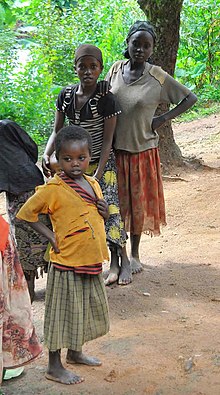Aari or Ari are a tribal Omotic people indigenous to Omo Valley of Ethiopia. According to 2007 census there are 289,835 ethnic Aari in Ethiopia, which makes up around 0.29% of the country's total population. Nearly all Aari speak the South Omotic Aari language, though more than half of them are multilingual and can also speak other languages such as Amharic.[1]: 73 [2]

History
editUntil the 19th century, Aari people lived under independent chiefdoms. The divine ruler of the Aari tribal societies were called baabi.
In the late 1800s, the Omo River region was conquered by the Ethiopian Empire under Emperor Menelik II of Ethiopia, which resulted in the widespread adoption of Amharic culture and the Amharic language there.[3] By the early 1900s, the Amhara rulers had consolidated their control over the region and many Aari became serfs.[4] Aari culture experienced significant decline during this time, although it and the Aari language survived.[3] In 1974 Derg, a Soviet-backed militia, overthrew the monarchy. The revolution brought down the feudal system under which the Aari had been forced to live, which allowed farming communities to keep their harvests and livestock and resulted in improved prosperity. After the Derg was overthrown in 1991, Ethiopia adopted a federalist system that granted self-determination to the country's ethnic groups, allowing the Aari to reclaim a degree of sovereignty over their lands. Particularly since 2000, the Aari's social and economic situations have improved dramatically[5] and interest in education has flourished; most Aari towns today have at least one primary school.[6]
Society
editCaste system
editThe Ari peoples of Ethiopia comрrise different occupational groups and their society is socially divided and stratified according to each Aari individual's respective occupation. The lower castes of the society is composed of potters, tanners and blacksmiths and collectively named as mana in the Aari language. Blacksmiths (faka mana)i who also do woodworking are marginalized and occupy an inferior position to tanners and potters (tila mana). Kantsa is the name given to the agriculturalist caste which holds a privileged position in the society. Intermarriage between mana and katsa is forbidden and considered as taboo according to Ari customs. The occupational segregation and caste-based endogamy practiced among the Ari have been revealed by advances in archaeogenetics to be one the oldest continuous caste systems in existence.[7] After the introduction of Christianity the social division between Christian Aari belonging to differing castes have reported to become less important. More of the societies make agriculture their livelihood, and most of them practice mixed farming.[8]
Religion
editMost Aari follow either Protestant Christianity or traditional beliefs. A few practice Orthodox Christianity.[9]
After conquest by the Ethiopian Empire in the late 1800s, many Aari were forced to convert to Orthodox Christianity,[3] although this religion became heavily stigmatized due to its association with the invading forces and perceived economic exploitation by Orthodox priests.[10] In the 1950s, large numbers became Protestants as a result of Western missionary work (especially by SIM). Today, the vast majority of Aari Christians are Protestants.[10]
See also
editReferences
edit- ^ "Ethiopian Census 2007". csa.gov.et. Addis Ababa: Ethiopian Central Statistics Agency. 2007. Archived from the original on 2011-07-28. Retrieved 9 July 2021.
- ^ "Aari". Ethnologue. Retrieved 2021-07-31.
- ^ a b c Barnes, Lawrie; van Aswegen, Kobus (November 2008). "An investigation into the maintenance of the Maale language in Ethiopia". African Identities. 6 (4): 431–444. doi:10.1080/14725840802417984. ISSN 1472-5843. S2CID 144473850.
- ^ Naty, Alexander (1994). "The Thief-Searching (Leba Shay) Institution in Aariland, Southwest Ethiopia, 1890s-1930s". Ethnology. 33 (3): 261–272. doi:10.2307/3774010. JSTOR 3774010.
- ^ Sommerschuh, Julian (2020-10-04). "From Feasting to Accumulation: Modes of Value Realisation and Radical Cultural Change in Southern Ethiopia". Ethnos. 87 (5): 893–913. doi:10.1080/00141844.2020.1828971. ISSN 0014-1844. S2CID 225153643.
- ^ Noguchi, Mariko (March 2013). "Aging among the Aari in rural southwestern Ethiopia: livelihood and daily interactions of the "Galta"". African Study Monographs. 46: 135–154. doi:10.14989/173537.
- ^ David Reich (2019), Who We Are and How We Got Here: Ancient DNA and the New Science of the Human Past ISBN 978-019-882-1250, pages 219-223. Quote: "Today there is an intricate caste system that shapes the lives of many people within Ethiopia, with elaborate rules preventing marriage between groups with different traditional roles. The Ari include three subgroups--the Cultivators, Blacksmiths, and Potters--who are socially and genetically differentiated from one another and from non-Ari groups. Since the Ari have a distinctive genetic affinity to the forty-five-hundred-year-old ancient highland individual compared to other Ethiopian groups, it is clear that there were strong local barriers to gene exchange and homogenization within the region of present-day Ethiopia that persisted for at least forty-five hundred years. This is the best example of strong endogamy that I know of even more ancient than the evidence of endogamy in India that so far is only documented as going back a couple of thousand years."
- ^ Terashima, Hideaki; Hewlett, Barry S. (2016-10-22). Social Learning and Innovation in Contemporary Hunter-Gatherers: Evolutionary and Ethnographic Perspectives. Springer. ISBN 978-4-431-55997-9.
- ^ Gebre, Yntiso (December 2010). "Cultural contact and change in naming practices among the Aari of southwest Ethiopia". Journal of African Cultural Studies. 22 (2): 183–194. doi:10.1080/13696815.2010.506387. ISSN 1369-6815. S2CID 153922382.
- ^ a b Böll, Verena; Kaplan, Steven; Alos-Moner, Andreu Martinez d' (2005). Ethiopia and the Missions: Historical and Anthropological Insights. LIT Verlag Münster. ISBN 978-3-8258-7792-7.
Further reading
edit- Alexander., Naty (1992). The culture of powerlessness and the spirit of rebellion among the Aari people of southwest Ethiopia : a dissertation. OCLC 1206449840.
- Gebre, Yntiso (2010-11-15). "Cultural contact and change in naming practices among the Aari of southwest Ethiopia". Journal of African Cultural Studies. 22 (2): 183–194. doi:10.1080/13696815.2010.506387. ISSN 1369-6815. S2CID 153922382.